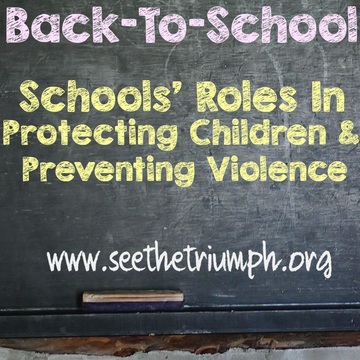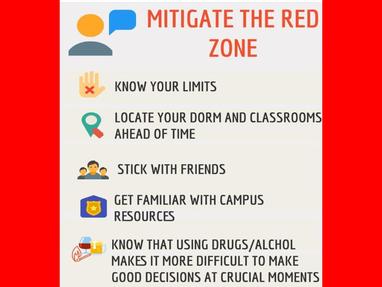|
By Jen Jones, See the Triumph Guest Blogger Note: While intimate partner violence can happen in various circumstances (e.g., female perpetrators, same-sex relationships, etc.), this blog post will focus on male-perpetrated violence against women. Recently, I came across Tony Porter’s TED talk on the socialization of men. You can watch it here. This 11-minute video blew me away. Tony describes the messages that we give to our boys…messages like, “Be a man! (and, being a man is defined by having power and control, especially over women)” and “Women have less value and are sexual objects to be conquered or property to own.” These messages are not new to us; they’ve been taught by our culture for generations. But, these messages breed attitudes in men that perpetuate and justify violence against women. Additionally, our culture may not be the only place that boys receive these messages. Existing research indicates that children who grow up in violent homes are at greater risk to experience violence in their adult relationships (Murray & Graves, 2013). Witnessing domestic violence at home can lead kids to believe that abuse is normal or that controlling someone is a good way to show them “love”. Our sons may have learned these messages from our very own homes. So, what can we do about it? How do we rewrite a script that has been engrained in our culture for generations? What will instill respect for women in our young boys? To begin, staying silent about the issue will never result in positive change. Just TALKING about what healthy versus unhealthy relationships look like and challenging the societal messages is a good start. Does the idea of talking to your teenage son about relationships and all the accompanying potentially awkward topics make you start to sweat? Feeling a little uncomfortable? If so, consider the following five tips to help get you started: 1. Embrace the awkwardness. As humans, we tend to avoid all things that make us feel uncomfortable. Accept that tough conversations might be awkward at first, but the consequence of our silence is far worse. Our silence leaves boys learning about relationships from media, a violent society, and enlarged egos in teenage boy’s locker rooms. Instead, let’s lean into the awkwardness and with a morsel of bravery and lots of humility. Let’s start conversations about love, respect, and dating relationships with our sons. It may help ease the awkwardness by having these conversations while taking a walk, eating a meal, or riding in the car. 2. Ask open-ended questions. Open-ended questions encourage discussion and elicit more than a simple “yes” or “no” response. For example, you can ask, “What do you think a healthy relationship looks like?” Or, “how do you show a girl you like her?” You can use examples from movies and television shows you watch together to spark discussion about the words, actions, and attitudes that men use to control women. Be genuinely interested in what they have to say about their own experiences with relationships. 3. Then, LISTEN. I know you have a lot you want to say about healthy relationships, but with teenage boys, you have to earn the right to be heard and often that is earned through listening first. Resist the urge to interrupt, analyze, or criticize what they say. Instead, ask follow-up questions which shows you were really listening. 4. Enlist some help. Older men often have a profound impact on younger men’s lives, so make sure your son has some great male role models who show respect for their partners and foster healthy relationships. 5. Keep it up! This is not a one-and-done conversation. Make it an ongoing discussion. Keep your eye out for real life examples that create opportunities for you to talk about dignity and respect for all people. Has this blog sparked your interest? Here are some additional resources that might help you in continuing this conversation in your family: www.LoveIsRespect.org www.acalltomen.org References:
 Jen Jones is a Masters student studying Couple and Family Counseling at the University of North Carolina at Greensboro. She has six years of experience working with kids and teens at a Christian summer camp, and looks forward to working with families in the future. By Heather Teater, See the Triumph Contributor
Children today can be impacted by many different types of violence – intimate partner violence between their parents, direct abuse from family members, bullying at school, terrorism and violence in the news, dating violence in their own relationships – the list goes on and on. One area of violence that has been particularly on my mind since beginning my work with students has been the violence that occurs in schools. And I’m not just talking about the tragedies that we see in the news in the form of mass shootings – no one can deny that these experiences are traumatizing, even for those who were not directly involved. The violence that I think about most often is much more commonplace. Children who experience, witness, or participate in bullying, fights, and dating violence need our attention as well. Putting an end to violence in schools is often seen as the responsibility of the school system, and to a large extent this is true. However, in order for true change to happen parents need to be involved in violence-prevention as well. Asking parents to take responsibility for violence in their children’s schools may seem ambitious, silly, even unreasonable, but if every single parent would help their own child(ren) understand the impact and consequences of violence, who would be left to perpetrate or perpetuate the violence? I know this is idealistic and that it is unlikely that we could get every parent to do anything, but why not take responsibility for your part? For those of you who are willing to try, here are a few concrete examples of how to prevent violence in your child’s school: 1) Try to keep your home violence-free. This seems like a suggestion loaded with controversy. I’m not saying that you have to keep your children from watching superheroes in Saturday morning cartoons, but they need to understand the difference between violence on television and violence in real life – a distinction that can be difficult, particularly for young kids. Keeping the discussion about the effects of real violence will be key in deciding whether or not your children are ready to handle watching violence on television. More controversial is the audacity to suggest that anyone chooses to stay in a house of violence - but that’s not what I’m suggesting. I realize that families can be stuck in a situation with domestic violence with no safe option to escape. In those situations it is important to keep a running discussion with your children to let them know that violence is not the answer, even if one parent seems to be demonstrating that to be so. What I am also trying to say is: don’t take violence lightly in your household – don’t punch each other in the arm as a “playful” gesture or spank someone as you walk by. We want our children to understand that being aggressive toward others is not okay in any situation - whether serious or playful. 2) Talk to your children about violence. Let your children know that it’s okay to ask questions or talk about things that they have witnessed/experienced at school. Talking to your kids about bullying and aggressive behaviors that they see at school can be a helpful way to get them talking about what they can do to stop the violence at school. 3) Don’t encourage your children to “fight back” when bullied. The last thing that any of us want is to see those we love being bullied. It can be so easy to fall into the trap of telling your children to defend themselves, especially when we feel that teachers and administrators are not doing enough to prevent/address bullying going on in their schools. But teaching our kids to fight back is teaching them that violence can sometimes be the answer, and we don’t want that kind of gray area in their lives. 4) Seek professional help when your child has any part (the victim or the perpetrator) in school violence. Though we don’t want your children physically fighting back against bullies, we do want to make sure that they are getting the support that they need. Being bullied can be very harmful to your child’s sense of self-worth and bullying others can be a sign of a deeper emotional hurt going on with your child. 5) Encourage other parents to do the same. Talk to the parents of your children’s friends - see what they are doing to help prevent violence in school and bounce some ideas off of each other. If they haven’t thought at all about violence-prevention, give them some suggestions and let them know the importance of helping their kids be a part of the solution. 6) Talk to your local school districts to see how you can be involved in preventing violence in your schools. Some schools already have initiatives in place to help prevent and eliminate violence. See if your school districts need help implementing or continuing these initiatives. If they don’t have any programs in place, see how you can help them develop one! Preventing violence in schools is no easy task, but if we all band together and do our part we can feel safe sending our kids to school once again. 9/1/2015 Back-To-School: Schools' Roles in Protecting Children and Preventing Violence, Series IntroductionBy Christine Murray, See the Triumph Co-Founder
It’s September, which means that it’s back-to-school season for students, parents, teachers, and other school employees. Back-to-school season can be filled with both excitement about the year to come and stress as families and schools adjust to new schedules and routines. The start of a new school year is a great time to make goals for a positive year ahead. At See the Triumph, we’re using this back-to-school season to focus on ways that schools can help to prevent and respond to violence. Specifically, we’re focusing on ways that personnel in elementary, middle, and high schools can take proactive steps to support children who’ve been impacted by violence and to create safe, nonviolent school climates. We believe that school personnel--including teachers, principals, counselors, and coaches--have opportunities to make a huge impact on the lives of their students. School personnel have a valuable window into their students’ lives, and with their daily contact with students, they are often among the first to notice when students are at risk for or already experiencing violence. We know that teachers and other school personnel have many demands on their time and energy already, especially as many schools across the country have moved to a greater focus on testing and assessment of students. And, often, schools are under-funded and under-resourced, so many teachers and other school employees face daunting jobs in carrying out their primary mission of educating students. Thus, we know that adding a focus on violence prevention and response can seem overwhelming to school personnel, in light of the demands they already face in their work. And yet, violence in its many forms can take a toll on students’ lives and academic performance. When bullying or school violence occurs, the resulting safety threats can damage the safe, supportive learning environment that children need to thrive. Children who witness violence in their homes can experience trauma symptoms that impact their ability to concentrate in school and can reduce their confidence in their ability to succeed in school. Teenagers who face abusive dating relationships may be controlled by a partner in ways that impact their involvement in school, social, and extracurricular activities. And these are just a few examples of the ways that schools can be impacted by violence--either within schools or in the homes of their students. This month, we invite you to consider ways that you can support local schools in efforts to prevent and respond to violence. If you’re a parent or teacher, start conversations within your school to learn about what efforts your school is or can take to address this important issue. If you work in an agency that address domestic and/or sexual violence or child maltreatment, consider how you can build partnerships with local schools to help impacted students get better connected with local resources, as well as to bring educational programming to teach students about safe, healthy relationships. If you’re simply a concerned citizen, look for opportunities in your community to volunteer or otherwise support efforts to address violence and promote safety within schools in your area. Engaging schools in efforts to prevent and respond to violence is critical to supporting students and families in building safe, healthy lives and relationships. We hope you’ll share your own suggestions and experiences throughout this month to offer additional insights as to how schools can help to build safety within relationships, families, and communities! By Sara Forcella, See the Triumph Contributor
It’s just about that time again; college students across the United States are making Target runs, stocking up on mac-n-cheese, ordering their textbooks, and loading up vehicles, ready to make the move into university housing. This is an exciting time for both parents and students alike, but it can also prove to be one of the most dangerous times for students as well. The ‘red zone’ is a term used to describe a heightened risk of unwanted sexual contact, specifically for first- and second-year women. The span of the ‘red zone’ has been debated; however, most research suggests that it may last as long as to the end of the fall semester. The Office of Community Oriented Policing Services of the U.S. Department of Justice states, “College students are the most vulnerable to rape during the first few weeks of the freshman and sophomore years. In fact, the first few days of the freshman year are the riskiest” (p. 7). The ‘red zone’ is creates a seemingly perfect storm for sexual assaults to occur. During the first few weeks, up until the end of the fall semester, incoming students are overwhelmed by an influx of new realities and are forced to quickly alter the lifestyles they had adapted over the course of the previous 18 or so years. It’s now up to the students themselves to decide how late at night will stay out, who they’ll go out with, what or if they drink alcohol, what their sexual expectations and limits are, and much more. For most students, this is the first time where they have no real parental rules; they have complete autonomy over their lives. It is also a vulnerable time for freshmen because they are not as familiar with their surroundings as upperclassmen are. They may rely on other freshmen or even upperclassmen to help them get around or figure out the college culture (Flack et. al, 2008). Relying on others to get around or understand the college atmosphere can be both tricky and at times risky. It’s important that while students work on building new friendships and relationships they rely on their instincts--trusting their gut is one of the main ways students can keep themselves safe their first few weeks on campus. Fraternity and sorority life activities also compound this increased period of danger with their “rush” weeks. It’s common for traditional fraternities and sororities to rush new members during the first few weeks of school. Typically this means that fraternities have an increased number of off-campus, parties where alcohol and drugs are easy to obtain. Due to the culture of many fraternities, this also provides an opportunity for upperclassmen to take advantage of the “naive newcomers” (Flack et. al, 2008). A 2008 study found that approximately 1 in 3 women (30 %), reported experiencing at least some level of non-consensual sexual touching during this time (Flack et. al). This number may leave parents and students feeling uneasy; however, it’s important to know that there are ways to reduce one’s risk of being a victim of the ‘red zone.’ Sexual assault or unwanted sexual contact is never a survivor's fault. Ever! The way they dress, the amount they drink, the people they choose to hang out with and their amount of previous sexual activity have no impact whatsoever on one’s victimization. A sexual assault can only ever be blamed on the perpetrator(s). Nonetheless, it’s unhelpful to simply share this information with you, potentially leaving students and parents feeling scared and disempowered. There are ways that students can prepare themselves to have a fun, and hopefully safe, experience at college during their first semester. Here are a few things that incoming students may want to do to feel more empowered over their first-year experience during the ‘red zone’:
By Laura Gazzard, See the Triumph Guest Blogger
What is intimate partner violence? Have you ever heard of it? As a college student, now is a great time to learn the basics so you can identify it in friends, family, and even your own life. Intimate partner violence, or IPV, is a serious preventable public health issue that affects millions of Americans, and 16-24 year olds are the most affected population. The term IPV describes physical, sexual, or psychological harm by a current or former partner. There are also a few other types of abuse that can fall under this category and may be overlooked because they’re not necessarily violent behaviors. According to Break the Cycle and the CDC, here are a few examples of the different types of IPV, so you can get a better picture of what they look like. Keep in mind, though, that this list is just a few examples of the different ways relationships can be abusive. Physical abuse: Hitting, pushing, shoving, throwing, grabbing, shaking, slapping, punching, and using one’s physical strength to harm another person. Emotional or verbal abuse: Manipulation, making you feel worthless, making threats, yelling and screaming, humiliation, and isolation Sexual abuse: Forcing or coercing someone to do anything sexual they do not want to do, making someone afraid to say “no” to sexual activity, and humiliating someone sexually Digital abuse: Using any form of technology to harass or stalk someone else, checking someone’s accounts without permission, threatening messages sent via text or social media, and publicly sharing private photos or other information Financial abuse: Controlling one’s partner’s finances, getting in the way with your job success, taking your money, and ruining your credit Often, physical abuse is much easier to identify than emotional and psychological abuse, which can make it much harder to seek help if you do not know that something is wrong to begin with. Relationships can be healthy or unhealthy. It is important to know the difference, because unhealthy relationships can become very unsafe. Abusive relationships usually start with less noticeable tactics to control the partner and may lead to emotional or physical abuse, which both have very long-term effects on health, self-esteem, other relationships, and other areas of people’s lives. Here are ten warning signs that you may be in an unhealthy relationship: 1. Does the relationship seem overly intense or that it is moving too quickly? 2. Does your partner seem extremely jealous about you? 3. Does your partner try to control what you do? 4. Does your partner isolate you from others? 5. Does your partner try to sabotage you from being successful? 6. Does your partner criticize you? 7. Does your partner blame you for the way they treat you? 8. Does your partner seem very angry or hostile? 9. Have you tried talking to your partner about it and hear excuses in response, such as “It was just a joke” or “I didn’t mean to do it”? 10. Does your partner try to make you feel crazy and/or minimize their own actions? Do you recognize any of these behaviors in your relationship, a relationship of someone you know? Some controlling behaviors may seem to be positive or an intense sign of a partner’s love. However, they also can be precursors to abuse. If someone is violent even just once, physically or emotionally, the chances are very high that they will be violent again. Talk to someone else in your life about any possible abuse you or someone you know may be experiencing. Silence can make this situation worse, and there are trained professionals available to help you. If you are unsure whether any behaviors or dynamics in your relationship may be abusive, we suggest you call the National Domestic Violence Hotline (http://www.thehotline.org/, 1−800−799−7233 or TTY 1−800−787−3224) or speak to a trained counselor at your college. Laura Gazzard is a graduate student in the Couple and Family Counseling track in the UNCG Department of Counseling and Educational Development. By Kiricka Yarbough-Smith and Roxy Logan The Trafficking Victims Protection Act (TVPA) recommends a four-pronged approach to addressing human trafficking: Prevention, Protection, Prosecution, and Partnership. Unfortunately, prevention is often an underfunded and underutilized tool in the fight against trafficking. Resource-strapped organizations, both public and private, are often restricted to reacting to trafficking cases rather than undertaking more systematic efforts to prevent future suffering and exploitation. To prevent trafficking, our movement must find innovative, low-resource, credible means of (1) addressing the emotional and material vulnerabilities of children most at risk for being trafficked and (2) confronting the cultural messages about masculinity and sexuality that drive willingness to sell or buy trafficked individuals. Educating populations vulnerable to trafficking is a critical component of prevention. Effective prevention programs should educate and provide outreach to particularly vulnerable populations of children to help combat the negative cultural and emotional forces that place them at increased risk for commercial sexual exploitation. This programming should help combat negative images children receive about sexuality from adults and the media, as well as focus on how to develop positive self-images and age-appropriate, healthy views of gender roles and sexuality. This programming is suitable for all demographic groups. Another technique some advocates have found useful is to reach out to the most vulnerable girls about the realities of prostitution and the techniques that traffickers might use to recruit them. Many trafficker-pimps initially portray sex work as a glamorous, easy way to make money and to earn the love and approval of the pimp. Traffickers carefully craft messages to lure in individuals based on their vulnerabilities, from the hopelessness engendered by multi-generational poverty to a basic desire for love. Programming must include a reality check for vulnerable young people on what the life traffickers offer really entails. Survivor-led programming here is likely to be the most effective, as youth are not always ready to listen to adults’ seemingly abstract admonitions about good long-term decisions. Because many pimps exploit children’s vulnerabilities by posing as loving boyfriends, caretakers, or a surrogate family, prevention curricula also needs to teach previously abused or neglected girls to develop a healthy understanding of love that is free of abuse and exploitation. These programs are especially important for the most vulnerable demographics, such as urban low-income youth most likely to be targeted because of their lack of economic options and foster care children who may never have known what a healthy, loving family life is like. It is important to offer after-school programs and hope for a better life to populations vulnerable to involvement in trafficking, whether as perpetrators or victims. Some advocacy groups have recently begun to offer resources for mentorships, internships, and constructive after-school activities that build self-esteem and offer legal, non-exploitative paths to financial and life success. To get the word out about such programs, advocates can offer materials and small group sessions to parents or youths in a targeted area. Depending on resources available, groups can also plan large-scale public events that bring in audiences through fun offerings, then give groups access to parents and youth who can use these resources. Any single group can only reach a limited number of youth state-wide, so it is important for both large, top-down and smaller grassroots groups to collaborate to expand the reach of prevention efforts. To accomplish this, advocates can offer leadership programs that train youth to become effective movement leaders and advocates in their own communities. Larger groups not performing direct services and outreach can support these programs by offering logistical training to help existing agencies around the state to train and engage youth. Community volunteers may also help expand the movement’s real reach, as well as link vulnerable groups to a wider variety of community resources. To help expand community members’ involvement, groups may find it helpful to enlist and train volunteers from numerous disciplines to help expand prevention work into more workplaces and organizations. To prevent trafficking, we must also address the availability and demand for trafficked people. The majority of sex traffickers and purchasers are male, so educating men and boys is essential to preventing trafficking. Organizations should work to reduce male participation in sex trafficking and similar forms of gender-based oppression by addressing unhealthy norms about gender-based dominance and instilling healthy, respectful models of masculinity. Challenging damaging views of gender and sexuality is critical to addressing demand. The women’s movement has made major gains in addressing women’s equality, but today we are losing traction on developing a healthy, egalitarian sexual culture. Today, media from pornography to music videos often provides a haven for an anti-women backlash, in which gender roles are clear and regressive. To reduce demand, we must offer more positive forms of education about healthy sexuality and openly confront the negative messaging about gender and sexuality that normalizes the sale and purchase of women for sex. To increase credibility with young boys, it helps to involve male staff members and, where possible, male athletes (local or national), musicians, political or business leaders, or other examples of positive male role models. These men can mentor boys on positive masculine identities and even work with athletic coaches to change the common terminology that devalues girls and reinforces links between sexuality, dominance, and aggression. The anti-trafficking movement’s prevention work must involve men in changing other men’s attitudes about commercial sex, respect for women as equals, and the meaning of healthy masculinity in our generation and those to come.  Kiricka Yarbough Smith provides training and technical assistance to service providers as well as resources and referrals to survivors of human trafficking. She also serves on the Executive Committee of The NC Coalition against Human Trafficking (NCCAHT) and co-chairs the NCCAHT committee to develop and implement Human Trafficking Rapid Response Teams across the state. She is also a member of Partner’s Against the Trafficking of Humans. Kiricka currently serves as a faculty member for the US Department of Justice Office on Violence against Women and Futures Without Violence project, building collaboration to address trafficking in domestic violence and sexual assault cases. She has also partnered with the Children Advocacy Centers of NC to develop and implement a domestic minor sex trafficking curriculum. Roxy Logan is an anti-trafficking activist, writer, and attorney. She currently serves as a board member and fundraising committee chair for the Rape Crisis Volunteers of Cumberland County. Previously, she assisted the North Carolina Coalition Against Sexual Assault with their human trafficking efforts. She earned her B.S. (magna cum laude) in Political Science from the University of Southern California, and her J.D. (cum laude) from William & Mary Law School. |
Archives
July 2024
CategoriesAll About Intimate Partner Violence About Intimate Partner Violence Advocacy Ambassadors Children Churches College Campuses Cultural Issues Domestic Violence Awareness Month Financial Recovery How To Help A Friend Human Rights Human-rights Immigrants International Media Overcoming Past Abuse Overcoming-past-abuse Parenting Prevention Resources For Survivors Safe Relationships Following Abuse Schools Selfcare Self-care Sexual Assault Sexuality Social Justice Social-justice Stigma Supporting Survivors Survivor Quotes Survivor-quotes Survivor Stories Teen Dating Violence Trafficking Transformative-approaches |
Search by typing & pressing enter




 RSS Feed
RSS Feed